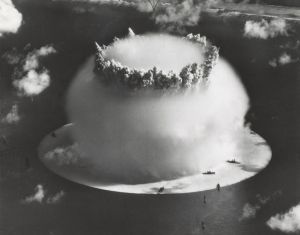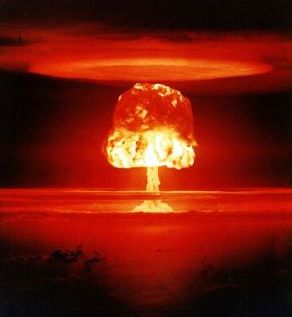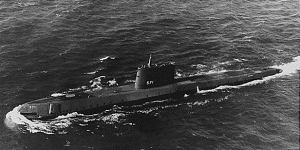![]()
II. From Hiroshima and Nagasaki
to the Cold War
III. The Industrial Atom:
Nuclear Energetics and the Cold War
| The Franck Report of June 1945, named for James Franck, recommended that the US either a) keep its atomic discoveries secret for an indefinite time, or b) develop nucleonic armaments at such a pace that no other nation would think of attacking first from fear of overwhelming retaliation. It also proposed that a demonstration of the ’new weapon’ be made before the eyes of representatives of all of the United Nations, on a barren island or desert. http://en.wikipedia.org/wiki/Franck_Report | Acheson-Lilienthal Report also known as the ’Report on the International Control of Atomic Energy’ (1946) An early United States Cold War document which tried to find an answer, at the point where only the United States had developed the nuclear bomb, to the question of whether to share knowledge of the bomb with the rest of the world, and how to prevent the evolution of international nuclear confrontations. http://en.wikipedia.org/wiki/Acheson-Lil... |
|
CMEA was part of COMECON. The Council for Mutual Economic Assistance which was an economic organization of communist states and a kind of Eastern Bloc equivalent to- but more inclusive than- the European Economic Community. The military counterpart to the Comecon was the Warsaw Pact. http://en.wikipedia.org/wiki/Comecon | The IAEA serves as an intergovernmental forum for scientific and technical co-operation in the peaceful use of nuclear technology. The IAEA’s programmes encourage the development of the peaceful application of nuclear technology, provide international safeguards against its misuse, and facilitate the application of safety measures in its use. IAEA expanded its nuclear safety efforts in response to the Chernobyl disaster in 1986. http://en.wikipedia.org/wiki/Internation... |
|
|
The first conference was held in July 1957 in Pugwash, Nova Scotia, hence the orgnization’s name. It was organized by Joseph Rotblat who served as secretary-general of the organization from its inception until 1973. The Russell-Einstein Manifesto became the Pugwash Conferences’ founding charter. http://en.wikipedia.org/wiki/Pugwash_Con... | At the time when the IAEA was established in 1957, only a limited number of countries had knowledge and experience in nuclear research, and especially its practical application. At the first International Conference on the Peaceful Uses of Atomic Energy, held in Geneva in August 1955 and attended by scientists and engineers from 73 countries, less than half of participating States were able to present reports on nuclear science or technology and only 12 of these States were from developing areas of the world. http://www-tc.iaea.org/tcweb/archives/ar... | The Joint Institute for Nuclear Research (JINR) in Dubna, Moscow Oblast (120 km north of Moscow), Russia is an international research centre for nuclear sciences, involving around 1000 scientists from eighteen states as well as some eminent and well-known scientists from UNESCO, CERN, CLAF, France, Germany, Italy, United States. http://en.wikipedia.org/wiki/Joint_Insti... | Physicians for Social Responsibility is an activist group and member of the International Physicians for the Prevention of Nuclear War. International Physicians for the Prevention of Nuclear War (IPPNW) is a worldwide grouping of national medical organizations. IPPNW uses research, education and advocacy to help prevent nuclear war and encourage the abolition of all nuclear weapons. http://en.wikipedia.org/wiki/Physicians_... | The first tests of the first Soviet nuclear missile R-7/SS-6 Sapwood started. http://www.astronautix.com/lvs/r7.htm | The Limited Test Ban Treaty was formally signed in Moscow by U.S. Secretary of State Dean Rusk, the Foreign Minister of the USSR, Andrei Gromyko, and the Foreign Minister of the U.K., Lord Home. The parties to the Treaty undertake ’not to carry out any nuclear weapon test explosion, or any other nuclear explosion,’ in the atmosphere, under water, or in outer space, or in any other environment if the explosion would cause radioactive debris to be present outside the borders of the state conducting the explosion. The Treaty is of unlimited duration. In the subsequenst years more and more countries joined the Limited Test Ban Treaty (LTBT). http://www.state.gov/t/ac/trt/4797.htm | The Chernobyl staff received permission to resume the reactor power reduction. One of the operators made a mistake. Instead of keeping power at 30%, he forgot to reset a controller which caused the power to plummet to 1% because of water which was now filling the core, and xenon (a neutron absorber) which was building up in the reactor. This amount of power was too low for the test. The water added to the reactor is heated by the neuclear reaction and turned into steam to turn the turbines of the generator. http://www.fatherryan.org/nuclearinciden... | |||
| 1945 ---------------------------|--------------------------- |
1946 ----------------------------|--------------------------- |
1946 ----------------------------|--------------------------- |
1949 -----------------------------|------------------------- |
1953 -------------------------------|----------------------- |
1954 --------------------------------|----------------------- |
1955 --------------------------------|---------------------- |
1955 --------------------------------|---------------------- |
1955 --------------------------------|---------------------- |
1956 ---------------------------------|---------------------- |
1961 -----------------------------------|------------------- |
1957-2-1 ---------------------------------|--------------------- |
1963-8-5 ------------------------------------|------------------ |
1986-4-25 ------------------------------------------------|------- |
II. From Hiroshima and Nagasaki
to the Cold War
III. The Industrial Atom:
Nuclear Energetics and the Cold War


